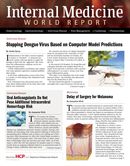Publication
Article
Internal Medicine World Report
NRAS and BRAF Status to Determine Melanoma Survival?
Author(s):
A recent study observed the likelihood of survival and other aspects of melanoma depending on a patient's NRAS and BRAF status.

In some cases melanoma can be a fatal disease for patients, which makes gaining as much knowledge about it as possible a critical task for medical science.
A recent study observed the likelihood of survival and other aspects of melanoma depending on a patient’s NRAS and BRAF status. The research results were published in the Journal of the American Medical Association Oncology.
The study followed patients over the course of 7.6 years and included a total of 912 patients from the United States and Canada as part of the Genes, Environment, and Melanoma (GEM) Study. The study ran from 2000 with initial diagnosis through 2007. The authors noted at that time both the US Food and Drug Administration and Australian Therapeutic goods Administration” began approving new systemic therapies that improve overall survival in patients with metastic melanoma.”
Looking at the final results, the team determined that melanomas were 13% NRAS+, 30%BRAF+, and 57% had neither NRAS nor BRAF mutation (wild type [WT]). The studied several factors including age, melanoma-specific survival, and site of the melanoma on the patient’s body.
The researchers noted that NRAS+ “has a more immunosuppressed microenvironment, which may affect its response to immunotherapies.” Data also showed a greater likelihood of death for “higher-risk tumors harboring NRAS or BRAF mutations after adjusting for other prognostic factors compared with WT melanomas.”
As a result, they believe it indicated, “that the prognostic implication of these mutations deserves further investigation, particularly in higher-AHCC stage primary melanomas.”
While Despite prior studies, the authors noted that the majority “have been mostly retrospective and examined all-cause rather than disease-specific survival.”
The report found NRAS and BRAF mutations appeared to have been mutually exclusive in patients and that “NRAS+ primary melanoma was independently associated with lower tumor-infiltrating lymphocyte grade.”
Overall the authors did find links between NRAS+ and BRAF+ melanomas, particularly higher tumor stage at diagnosis, which they said, “indicates that NRAS+ and BRAF+ melanomas are less likely than WT melanoma to be diagnosed when lower risk and surgically curable.” They added, “The association of NRAS+ melanoma with lower TIL grade may influence its response to immunotherapies.”





